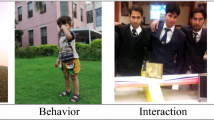Abstract
Occlusion is an important factor for analysis of human gait recognition in real-time scenarios. In multi-person gait (MPG) or dynamic occlusion, gait recognition is affected due to occluded body parts known as region of interests (ROIs). The aim of this article is to reconstruct the occluded ROIs and measure the errors associated with the reconstruction methods. The contribution of this article is threefold: firstly, we segment five dynamic ROIs; secondly, reconstruction of ROIs using Lagrange, piecewise cubic hermite (PCH) and cubic spline and thirdly, a comparison among the above methods in MPG scenario. We consider the human body into two parts, i.e., lower and upper body. In lower body, we have considered ankle, while knee in upper body: wrist, elbow, and shoulder have been considered. The dataset used in this study consists of dynamic occlusion scenarios. The quantitative assessment of the above methods are based on four parameters such as mean square error, root mean square error, mean absolute error and mean absolute percentage error. Results show that PCH consistently outperforms the other methods in the reconstruction of occluded ROIs in MPG scenario.













Similar content being viewed by others
References
Kale, A., Sundaresan, A., Rajagopalan, A.N.: Identification of humans using gait. IEEE Trans. Image Process. 13(9), 1163–1173 (2004). https://doi.org/10.1109/tip.2004.832865
Lee, T.K.M., Belkhatir, M., Sanei, S.: A comprehensive review of past and present vision-based techniques for gait recognition. Multimed. Tools Appl. 72(3), 2833–2869 (2014). https://doi.org/10.1007/s11042-013-1574-x
Wang, Liang, Tan, Tieniu, Weiming, Hu, Ning, Huazhong: Automatic gait recognition based on statistical shape analysis. IEEE Trans. Image Process. 12(9), 1120–1131 (2003). https://doi.org/10.1109/TIP.2003.815251
Nixon, M.S., Carter, J.N.: Automatic recognition by gait. Proc. IEEE (2006). https://doi.org/10.1109/jproc.2006.886018
Zeng, Wei, Wang, Cong, Li, Yuanqing: Model-based human gait recognition via deterministic learning. Cognit. Comput. 6(2), 218–229 (2014). https://doi.org/10.1007/s12559-013-9221-4
Yoo, J.-H., Hwang, D., Moon, K.-Y., Nixon, M.S.: Automated human recognition by gait using neural network. In: First Workshops on Image Processing Theory, Tools and Applications (IPTA), pp. 1–6 (2008)
Yoo, Jang-Hee, Nixon, Mark S.: Automated markerless analysis of human gait motion for recognition and classification. ETRI J. 33(2), 259–266 (2011)
Bouchrika, I.: Parametric elliptic Fourier descriptors for automated extraction of gait features for people identification. In: 12th International Symposium on Programming and Systems (ISPS), pp. 1–7 (2015)
Choudhury, S.D., Tjahjadi, T.: Clothing and carrying condition invariant gait recognition based on rotation forest. Pattern Recognit. Lett. 80, 1–7 (2016). https://doi.org/10.1016/j.patrec.2016.05.009
Jia, S., Wang, L., Li, X.: View-invariant gait authentication based on silhouette contours analysis and view estimation. IEEE/CAA J. Autom. Sin. 2(2), 226–232 (2015). https://doi.org/10.1109/jas.2015.7081662
Ji, Ning, Sanchez, Victor, Li, Chang-Tsun: On view-invariant gait recognition: a feature selection solution. IET Biom. 7(4), 287–295 (2018). https://doi.org/10.1049/iet-bmt.2017.0151
Sharma, H., Grover, J.: Human identification based on gait recognition for multiple view angles. Int. J. Intell. Robot. Appl. (2018). https://doi.org/10.1007/s41315-018-0061-y
Li, Xiang, Makihara, Yasushi, Chi, Xu, Muramatsu, Daigo, Yagi, Yasushi, Ren, Mingwu: Gait energy response functions for gait recognition against various clothing and carrying status. Appl. Sci. 8(8), 1380 (2018). https://doi.org/10.3390/app8081380
Yu, S., Chen, H., Wang, Q., Shen, L., Huang, Y.: Invariant feature extraction for gait recognition using only one uniform model. Neurocomputing 239, 81–93 (2017). https://doi.org/10.1016/j.neucom.2017.02.006
Hofman, M., Sural, S., Rigoll, G.: Gait recognition in the presence of occlusion: a new dataset and baseline algorithms. In: Proceedings of the 19th International Conference in Central Europe on Computer Graphics, Visualization and Computer Vision, pp. 99–104 (2011)
Roy, A., Sural, S., Mukherjee, J., Rigoll, G.: Occlusion detection and gait silhouette reconstruction from degraded scenes. Signal Image Video Process. 5(4), 415–430 (2011). https://doi.org/10.1007/s11760-011-0245-5
Takemura, N., Makihara, Y., Muramatsu, D., Echigo, T., Yagi, Y.: Multi-view large population gait dataset and its performance evaluation for cross-view gait recognition. IPSJ Trans. Comput. Vis. Appl. 10(4), 1–14 (2018)
Yu, S., Tan, D., Tan, T.: A framework for evaluating the effect of view angle, clothing and carrying condition on gait recognition. In: 18th International Conference on Pattern Recognition (ICPR), pp. 441–444 (2006)
Sarkar, S., Phillips, P.J., Liu, Z., Vega, I.R., Grother, P., Bowyer, K.W.: The humanID gait challenge problem: data sets, performance, and analysis. IEEE Trans. Pattern Anal. Mach. Intell. 27(2), 162–177 (2005). https://doi.org/10.1109/TPAMI.2005.39
Singh, J.P., Jain, S., Arora, S., Singh, U.P.: Vision-based gait recognition: a survey. IEEE Access 6, 70497–70527 (2018). https://doi.org/10.1109/access.2018.2879896
Chen, X., Weng, J., Lu, W., Xu, J.: Multi-gait recognition based on attribute discovery. IEEE Trans. Pattern Anal. Mach. Intell. 40(7), 1697–1710 (2017). https://doi.org/10.1109/tpami.2017.2726061
Tafazzoli, Faezeh, Safabakhsh, Reza: Model-based human gait recognition using leg and arm movements. Eng. Appl. Artif. Intell. 23(8), 1237–1246 (2010)
Singh, J.P., Jain, S., Arora, S., Singh, U.P.: Dataset for human recognition under multi-gait scenario. Mendeley Data (2019). https://doi.org/10.17632/py4zw6g7xc.2
Lishani, A.O., Boubchir, L., Khalifa, E., Bouridane, A.: Human gait recognition based on Haralick features. Signal Image Video Process. (2017). https://doi.org/10.1007/s11760-017-1066-y
Nandy, Anup, Chakraborty, Rupak, Chakraborty, Pavan: Cloth invariant gait recognition using pooled segmented statistical features. Neurocomputing 191, 117–140 (2016). https://doi.org/10.1016/j.neucom.2016.01.002
Lopez-Fernandez, D., Madrid Cuevas, F.J., Carmona Poyato, A., Munoz Salinas, R., Medina Carnicer, R.: A new approach for multi-view gait recognition on unconstrained paths. J. Vis. Commun. Image Represent. 38, 396–406 (2016)
Hofmann, M., Wolf, D., Rigoll, G.: Identification and reconstruction of complete gait cycles for person identification in crowded scenes. In: International Conference on Computer Vision Theory and Applications, pp. 594–597 (2011)
Chattopadhyay, Pratik, Sural, Shamik, Mukherjee, Jayanta: Frontal gait recognition from occluded scenes. Pattern Recogn. Lett. 63, 9–15 (2015). https://doi.org/10.1016/j.patrec.2015.06.004
Isa, W.N.M., Alam, M.J., Eswaran, C.: Gait recognition using occluded data. In: IEEE Asia Pacific Conference on Circuits and Systems, pp. 344–347 (2010)
Chen, Xin, Yang, Tianqi, Xu, J.: Multi-gait identification based on multilinear analysis and multi-target tracking. Multimed. Tools Appl. 75(11), 6505–6532 (2016). https://doi.org/10.1007/s11042-015-2585-6
Chen, Xin, Jiaming, Xu, Weng, Jian: Multi-gait recognition using hypergraph partition. Mach. Vis. Appl. 28(1–2), 117–127 (2017). https://doi.org/10.1007/s00138-016-0810-6
Federolf, P.A.: A novel approach to solve the “missing marker problem” in marker-based motion analysis that exploits the segment coordination patterns in multi-limb motion data. PLoS ONE 8(10), 1–13 (2013). https://doi.org/10.1371/journal.pone.0078689
Gloersen, O., Federolf, P.: Predicting missing marker trajectories in human motion data using marker interconnections. PLoS ONE 11(3), 1–14 (2016). https://doi.org/10.1371/journal.pone.0152616
Liu, G., McMillan, L.: Estimation of missing markers in human motion capture. Vis. Comput. 22(9–11), 721–728 (2006)
Aristidou, A., Cameron, J., Lasenby, J.: Real-time estimation of missing markers in human motion capture. In: 2nd International Conference on Bioinformatics and Biomedical Engineering, pp. 1343–1346 (2008). https://doi.org/10.1109/icbbe.2008.665
Kharab, A., Guenther, R.B.: An Introduction to Numerical Methods A MATLAB Approach, 3rd edn, pp. 171–178. CRC Press, Boca Raton (2012)
Howarth, S.J., Callaghan, J.P.: Quantitative assessment of the accuracy for three interpolation techniques in kinematic analysis of human movement. Comput. Methods Biomech. Biomed. Eng. 13(6), 847–855 (2010). https://doi.org/10.1080/10255841003664701
Piecewise Cubic Hermite Interpolating Polynomial (PCHIP). [Online] http://www.ece.northwestern.edu/local-apps/matlabhelp/techdoc/ref/pchip.html. Accessed 1 Nov 2018
Tang, Siyu, Andriluka, Mykhaylo, Schiele, Bernt: Detection and tracking of occluded people. Int. J. Comput. Vis. 110(1), 58–69 (2014). https://doi.org/10.1007/s11263-013-0664-6
Author information
Authors and Affiliations
Corresponding author
Additional information
Communicated by T. Plagemann.
Publisher's Note
Springer Nature remains neutral with regard to jurisdictional claims in published maps and institutional affiliations.
Rights and permissions
About this article
Cite this article
Singh, J.P., Jain, S., Arora, S. et al. Reconstruction of occluded ROI in multi-person gait based on numerical methods. Multimedia Systems 26, 249–266 (2020). https://doi.org/10.1007/s00530-019-00641-9
Received:
Accepted:
Published:
Issue Date:
DOI: https://doi.org/10.1007/s00530-019-00641-9




